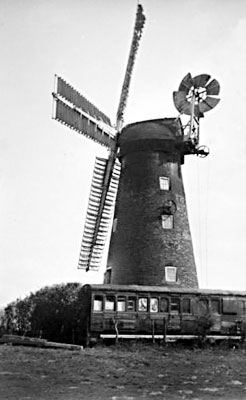
Billingford alias Pyrleston (Nr Diss) towermill |
 |
March 1934 |
|
Billingford
tower mill was built on the common to the south of Lower Street as a five storey red brick tower mill by W. Skinner in
1859-60 at a cost of £1,300 on the site of a postmill that was
destroyed in a gale shortly before. White's directory of 1845 and 1864 lists Billingford as alias Pyrleston. |
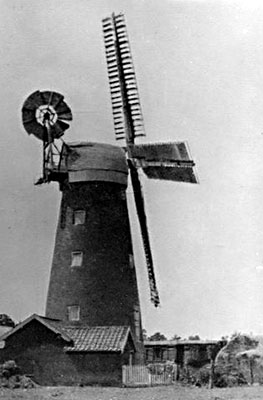 |
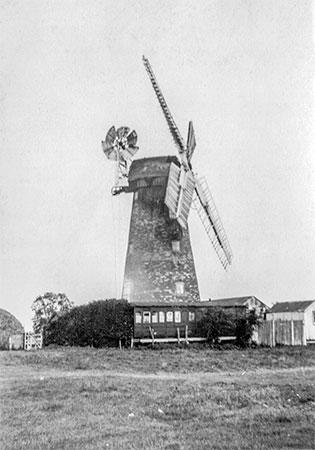 |
1934 |
Mill working - 29th July 1938 |
The Norfolk boat shaped cap with a petticoat was tarred in the latter years of its working life but was painted white during restoration. An unusual 6 bladed fantail replaced one of a more traditional design in the 1930s. Drive from the fan spindle to the rack on the curb was via a spur pinion. After restoration the mill had four wide double-shuttered sails each with 8 bays of 3 shutters that were operated by rack and pinion striking gear. The wooden clasp-arm brake wheel has iron section teeth and bears a tablet W. SKINNER 1860. The cast iron upright shaft was 4½ ins in diameter and the 5ft 4½ ins diameter spur wheel was the smallest recorded by Rex Wailes.The stones were on the second floor and overdriven via wooden cogged iron stone nuts. The mill originally drove two pairs of stones, one of which was restored to working order. A hurst frame supported a pair of composition stones that were sickle dressed and driven via an outside pulley on the second floor by an oil engine that was installed in 1928. The tower had two doors on the ground floor. |
TECHNICAL DETAILS |
| As worked:- 4 double shuttered sails with 8 bays of 3 vanes struck by rack & pinion Norfolk boat shaped cap with petticoat 6 bladed fan 5 floors with two opposite doors on the ground floor Iron upright shaft 4½ ins. diameter Brakewheel including tablet inscribed W. SKINNER 1860 Great spur wheel 5 ft 4½ ins. diameter 2 pairs of overdriven stones Auxiliary steam engine drive to 2nd floor via external pulley Sinlge pair of sickle dressed composite stones in hurst frame on ground floor driven by engine from 1928 As restored:- 4 double skeleton sails with 8 bays Columbian pine stock of 1962 replaced with a hollow steel stock in 1977 by Lennard & Lawn (Millwrights) Ltd. Fan disintegrated in gale of 2nd - 3rd January 1976 and later replaced Wind driven machinery down to levewl of stones All original outbuildings demolished |
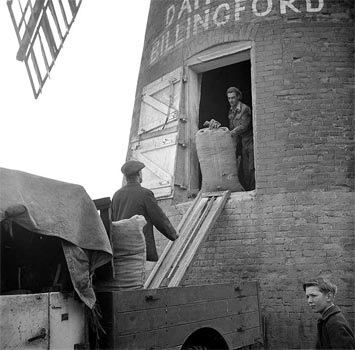 |
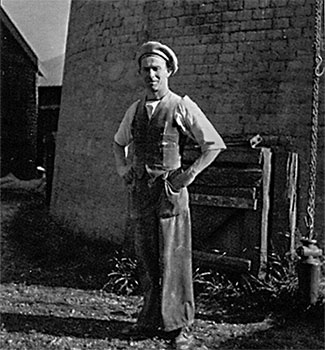 |
1950 |
Arthur Daynes c.1950 |
George Goddard who had been working the postmill at the time of its destruction, became the first tenant miller in March 1860 after William Chaplyn of Diss_Rose_Lane_mill built the new towermill. Edward Woodrow took over the mill c.1869 and brought with him his one year old son Charles Edward, who became the owner and miller at Lakenham_Peafield_towermill. Edward Woodrow moved to Scole_towermill in 1875 and then to Horsford St Helena towermill in 1883. |
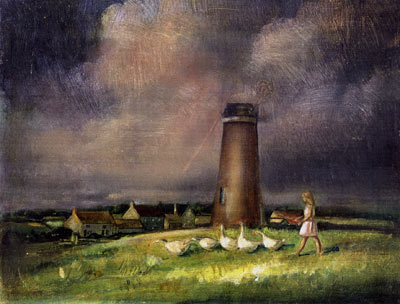 |
Oil painting by James Govier c.1950 |
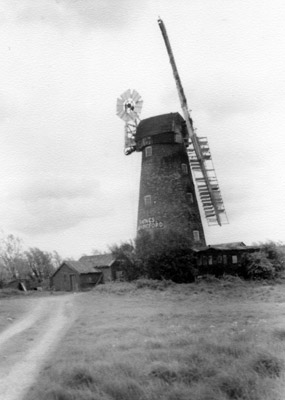 |
Daines Billingford signwritten on tower 20th May 1958 |
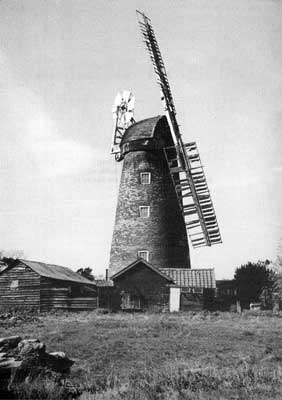 |
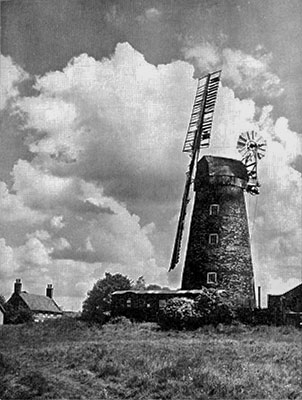 |
May 1957 |
1960 |
Houses etc. |
Diss County Court Wednesday (Before J. Worlledge Esq., Judge) A Curious Mixture Henry Pike, miller of Billingford sued George Jukes of Brome for £4.17s. for flour & meal supplied. (Summary:- Defence – some barley meal not fit to eat, a quantity of whiting mixed with the meal. Plaintiff admitted some starch fibre mixed in. Judgement for plaintiff, but less 30s. because of adulteration. “Plaintiff” ought to be ashamed of himself”. Not allowed costs) Norfolk News - 17th August 1872 |
John Button was miller for a short time around 1875 before movig to Diss Victoria Road mill in 1880. |
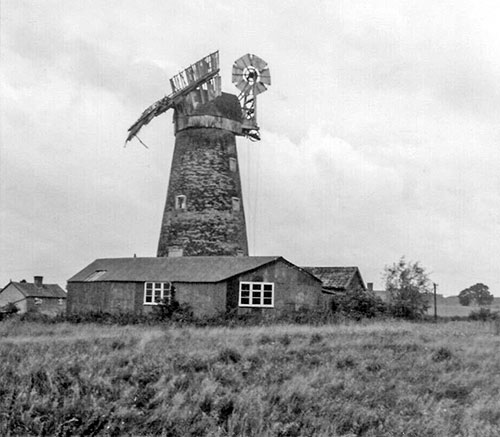 |
c.1960 |
Valuable mercantile & residential Properties comprising an excellent Steam & Flour Mill, Post Windmill, four capital Maltings with Barley Stores above & Maltsters houses adjoining, three pleasantly situated Dwelling houses with Gardens, Stables & Outbuildings attached, five Cottages & valuable piece of Building Land situate in the Victoria Road, Diss. Also an excellent Brick Tower Windmill situate on Billingford Common. Salter & Simpson are favoured with instructions from the executors of the late Mr. William Chaplyn to Sell by Auction at the Kings Head Hotel, Diss on Tuesday 21 June 1881 at 3 for 4 o’c in six Lots the above valuable Properties. Lot 3. The Brick & Tiled Steam Flour Mill containing four floors with excellent 14 horse power engine & new fitted 20 horse boiler driving four pairs of 4 ft. French Burr Stones with Flour mill & all necessary gearing. The Four-sail Post Windmill with brick roundhouse driving two pairs of Stones, Flour mill & gearing complete. The above are in the occupation of Mr. William Button. Lot 4. Residence. 0a.1r.32p. Victoria Road in occupation of Mr. Button. Lot 6. In Billingford A substantial built brick Tower Windmill containing five floors etc… Also Bake office, Stable & Cart shed attached situate on Billingford common now in the occupation of Mr. William Button. Possession of all Lots may be had at Michaelmas next. Particulars of Mr. T.W. Salmon, Solr. Diss or the Auctioneers, Attleborough. Diss Express - 6th May to 10th June 1881 |
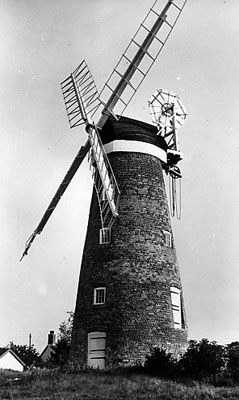 |
c.1968 |
Diss & Billingford Salter & Simpson are favoured with instructions from the Executors of the late Mr. William Chaplyn to Sell by Auction at the Kings Head Hotel, Diss On Tuesday June 21, 1881 at 3 for 4 o’c in Six Lots as follows:- IN DISS Lot 1. DWELLING HOUSE, Victoria road, Diss … Lot 2. White Brick & Slated RESIDENCE … Lot 3. Brick & Tiled STEAM FLOUR MILL containing four Floors with excellent 14 horse power Engine & new fitted 20 horse Boiler, driving four pairs of 4 ft. French Burr Stones, with Flour Mill & all necessary gearing. The Four Sail POST_WINDMILL with Brick Roundhouse, driving two pairs of Stones, Flour Mill & Gearing complete, Stable, Harness & Hayhouses, Cart Lodge, Granary & Loose Box. The above are in the occupation of Mr. William Button. Also two MALTINGS. Also DOUBLE TENEMENT. Lot 4 RESIDENCE in Victoria Road in the occupation of Mr. Button. Lot 5. BUILDING LAND. The above Properties are most advantageously situate within a short distance of the Railway Station & the rapidly improving Town of Diss. A lucrative Malting & Milling Trade has been carried on for many years & an unusual opportunity is afforded to those seeking a Mercantile Business or a safe investment for Capital. IN BILLINGFORD Lot 6. A substantially built Brick TOWER WINDMILL containing five floors, driving two pairs of stones & all requisite gearing for wind or steam power; also a Bake Office, Stable & Cartshed attached, situate on Billingford Common, now in the occupation of Mr. William Button. Possession of all the Lots may be had at Michaelmas next. Particulars of Mr. T. W. Salmon, Solr. Diss or the Auctioneers, Attleborough & Bury St. Edmunds. Norfolk Chronicle - 28th May & 4th June 1881 |
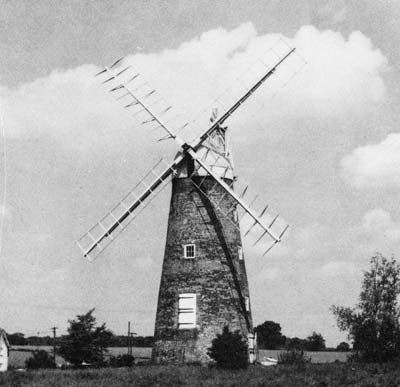 |
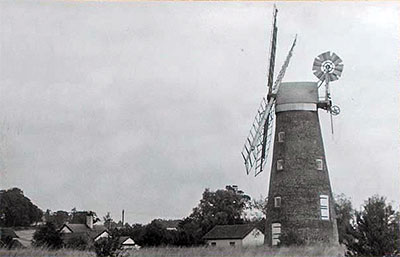 |
1st June 1971 |
1973 |
Billingford Mill for Sale or to Let A well built brick Tower Windmill with patent sails, two pairs of stones, wind & steam tackle with good machinery. Situate at Billingford, near Scole. Apply to W. F. Chaplyn, Diss Diss Express - 29th September, 6th & 13th October 1882 |
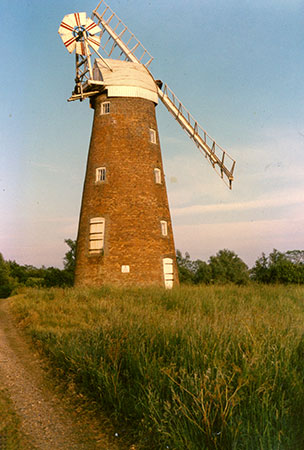 |
1989 |
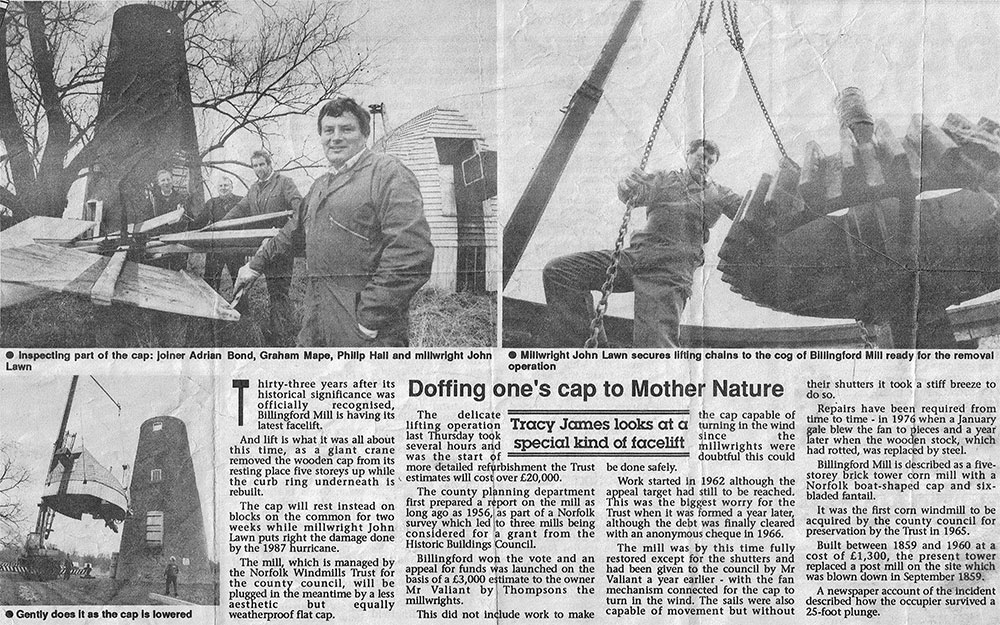 |
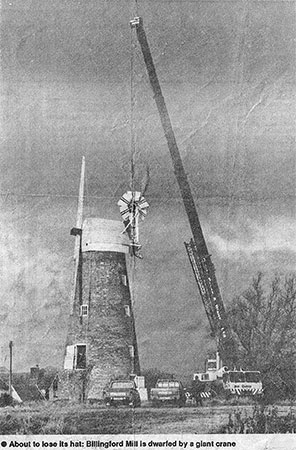 |
The Norfolk & Suffolk Express Series - 8th December 1989 |
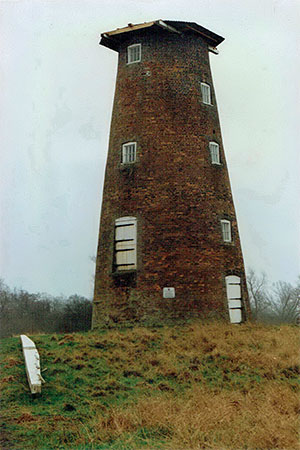 |
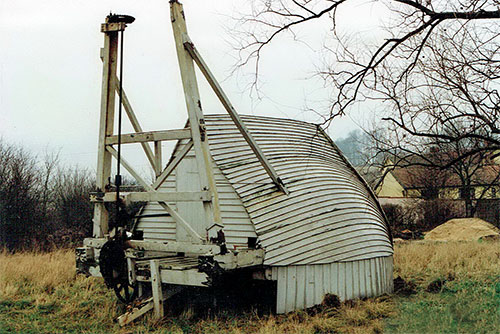 |
1989 |
1989 |
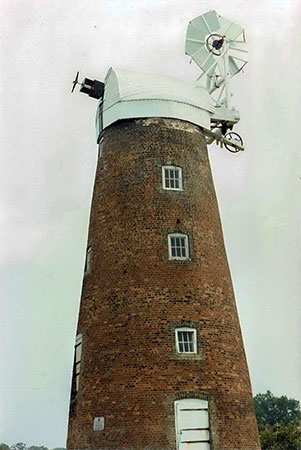 |
1990 |
George Arthur Daines bought the mill in 1924. He employed a Mr. Chase until son Arthur E. Daines started working with him in 1933 when they became known as G. A. Daines & Son. Arthur Daines served in the navy during the war, leaving in 1945. On his return, he spent £300 in mill repairs and worked the mill with two sails only. In 1956 the sails were damaged and the mill ceased working by wind, the last windmill in the county to do so. The mill continued to work for two more years using auxiliary power until trade fell away dramatically due to the 1958 outbreak of foul pest. |
|
The last miller was Arthur Daines who used windpower until 1956. By this time the mill was down to two sails and following further wind damage he reverted to auxiliary power before ceasing to work the mill in 1959. Billingford towermill was the last wind powered windmill to commercially work in Norfolk using wind power and after milling ceased it was sold to Mr. Valiant who restored the mill for future preservation that curiously included demolishing the surrounding mill buildings. On completion of the restoration work, with the help of donations from Norfolk County Council, SPAB and the Historic Buildings Council, Mr. Valiant donated it to Norfolk County Council and thus the mill became first to be acquired by the Norfolk Windmills Trust for preservation. |
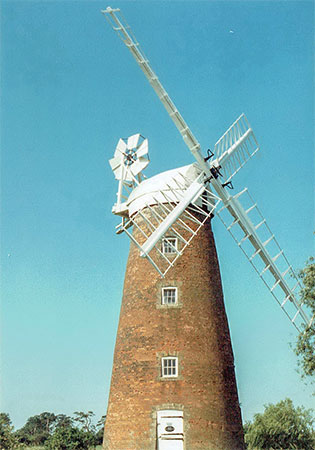 |
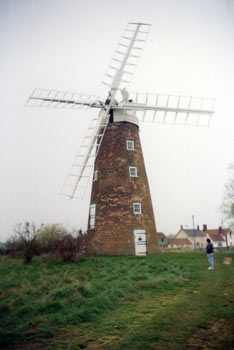 |
|
1992
|
April 1993 |
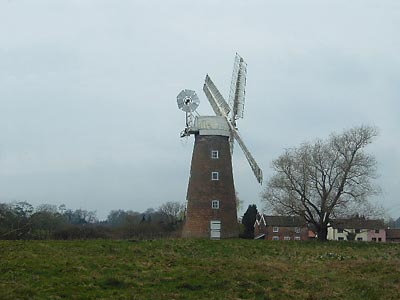 |
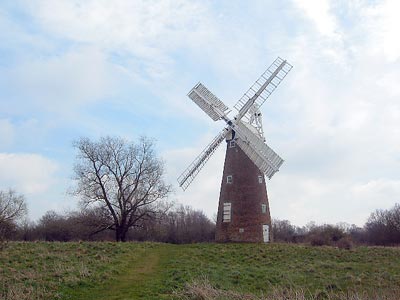 |
23rd March 2007 |
23rd March 2007 |
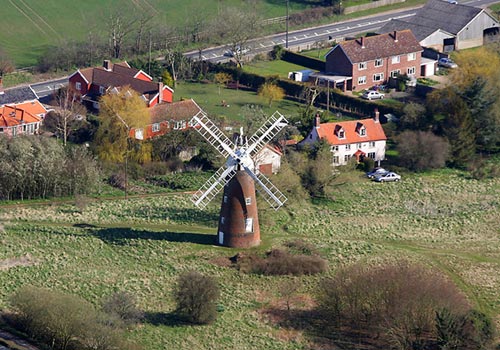 |
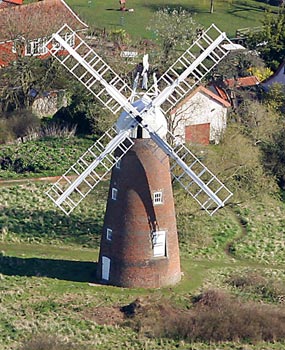 |
31st March 2008 |
31st March 2008 |
Busy Year at Billingford Windmill |
The busy schedule of events has been announced at Billingford Windmill by the Norfolk Windmills Trust. The mill will also be open for tours on Sunday, August 17, and on Sunday, September 21, a harvest exhibition of machinery and historic signs and books will take place. On all dates, except for June 8, the mill will be open for guided tours, between 12.30pm and 4.30pm, priced at adults £3, senior citizens £2, and children free. Admission to events on the common are free, while their will be buckets for donations at the gate. Billingford Mill is also on the lookout for an assistant to the present miller in a volunteer role. The job is to learn how the mill operates and to be able to operate the mill on completion of restoration, also involving health and safety issues for visitors and staff. The volunteer would be insured by Norfolk Windmills trust and once training is complete will be required to assist visitors tours of the mill. For information or to arrange a special visit for a group, club or school, call 01379 853967. |
As south Norfolk landmark Billingford Mill takes a step closer to restoration, a talk will take place on its history by the son of its last commercial miller. |
Big milestone in £150,000 Billingford Mill restoration project is 'capped' |
A huge milestone has been reached in a large restoration project at Billingford Mill in a bid to see it return to full working order. A 65 tonne crane had arrived to remove the stock and cap but, due to soft ground, the mill could not be accessed. Using about 20 tonnes of crushed concrete was used as a foundation, and a wooden road was installed. A few days later, with crane in position, the first stock seized in canister, and it took millwright's team three-and-a-half hours to ready the extraction by crane. The second took nearly four hours to free off ready for lifting, and a day later the cap was removed and transported to the millwright's works for restoration. Martin Wilby, Chairman of EDT at NCC said: "I would like to thank all of the Friends of Billingford Windmill and all of the local volunteers that have raised the funds required over the last three years to make this day happen. "This shows that the project of restoration is starting and I look forward to the day when the Mill is in full working order with its new sails turning in the wind and the flour being ground. The Billingford Mill restoration and education project will cost almost £150,000 and include repairs and alterations to the cap, new timber stocks and sails along with training for new millers and guides, an updated guide book and a sponsors board in the mill. The works will be completed in 2018 when the mill will once again produce flour for demonstration purposes. The project is led by the Norfolk Windmills Trust, working in partnership with the Friends of Billingford Windmill and Norfolk County Council. The Trust was founded by the County Council in 1963 and looks after 20 corn and drainage mills throughout Norfolk. As part of the project volunteer training will be provided in particular to prospective millers and guides. Those interested should contact amanda.rix@norfolk.gov.uk or 01362 869394. Diss Express - 1st March 2017 |
'Top-less' windmill could have cap and sails restored within a year |
A "top-less" windmill that had its sails removed for renovation is set to be turning again with the next year. Billingford Mill has been a feature of the South Norfolk countryside for more than 200 years. But its cap and sails were removed last year as part of a refurbishment project to restore the ageing mill, which had been battered by wind over several decades, to be restored to its former glory. Amanda Rix, historic environment officer for Norfolk County Council, said: "A fully enclosed scaffold was erected in January to enable works to continue beneath. "Works began by lifting the wooden kerb and iron track that sits on the top of the tower. "This enabled the builders to access the brickwork beneath so that the damaged brickwork could be dismantled and rebuilt." On further inspection, it was discovered that sections of iron bars in the mills structure had cracked. Ms Rix added: "Some repairs have been carried out to the windows and doors and cracks in the brickwork have been stitched. "But it was discovered whilst lifting the kerb that over half the iron track sections that sit on the timber curb were found to be cracked and needed to be renewed. "New castings have been made and are in the process of being milled." Brickwork repairs are expected to be completed within the next month in preparation for the cap and sails to be put back on. Ms Rix said: "The cap will be hoisted back onto the mill and left to wind before the stocks and sails are fitted in spring 2019, when the sails will once again be able to turn and grain be ground at the mill." The mill is owned by Norfolk County Council and maintained by the Norfolk Windmills Trust. The project was developed with the involvement of the Friends of Billingford Windmill, which is chaired by land owner Sir Rupert Mann. The work on the mill would not have been possible without the hard work of fundraisers and volunteers. Volunteers are needed for a number of roles around the site, especially to train as millers and guides so that the mill can be opened more frequently. Anyone interested should email amanda.rix@norfolk.gov.uk Diss Mercury - 16th June 2018 |
Landmark windmill gets its cap back on |
||||
Its iconic sails had turned for more than 150 years, now one of the most picturesque landmarks in the Norfolk landscape is a major step closer to being fully restored to its original glory. In a careful operation the newly renovated iconic white wooden cap was gently lifted up and lowered on to the top of Billingford Mill using a giant crane. The cap - or roof - had been lifted off in 2017 to go to a millwright's works for restoration. Its return marks a major step in a £150,000 project on the Grade II listed mill near Diss.
A new set to sails and stocks, the giant timbers that hold them in place, are currently been made before being attached, hopefully sometime later this summer, restoring the mill to its full glory with sails turning for the first time in a decade. Suffolk-based millwright Tim Whiting, who was overseeing the operation, said: "The cap has been restored in Saxmundham and has been put back to how it was originally. We produced drawings to match original photographs from as far back as we could find. It is a completely new profile to what many people will remember. It will look different, but it looks amazing." Vital rebuilding work has had to be carried out on the tower to repair damage cause by very heavy steel stocks that were installed in the 1980s.
Billingford Mill was built in 1860 by W Skinner for the princely sum of £1,300 and was a large source of flour production in the area. It ceased to be used as a commercial mill in the 1950s and was the last of its kind to be operated as a wind-powered commercial mill in Norfolk. It is now overseen by mill custodians Julie and Herbert Websdell, who look after the Norfolk County Council-owned site on behalf of the Norfolk Windmills Trust. Despite not operating as a fully-functioning mill, Mr and Mrs Websdell have still held open days and demonstrations to visitors. The next open day is June 9. Mr Websdell said: "People have been able to see parts of the building that are not normally seen. We recently discovered graffiti in the tower that goes back to 1889. "We will be milling again when it is up and running. When you get the sails working it is very therapeutic. It just trundles away and now it should be even better. Before the stocks weighed over four tonnes, the new ones will be about a tonne so we should get a lot more wind power from it." Simon Parkin, Diss Mercury - 23rd May 2019 |
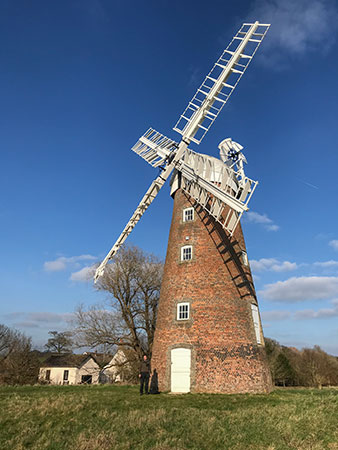 |
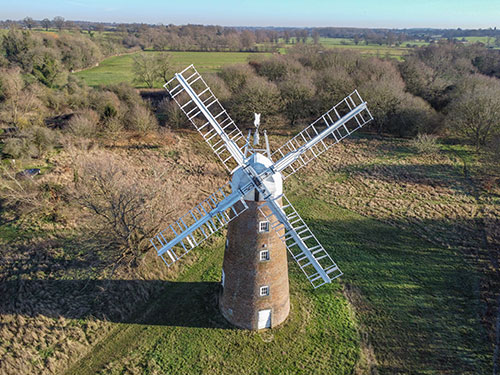 |
Tim Whiting, millwright standing in front of the mill 22nd March 2021 |
18th January 2022 |
New sails were installed onto the mill in September 2020 by millwright Tim Whiting. |
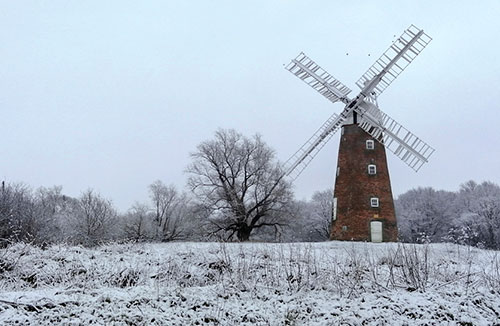 |
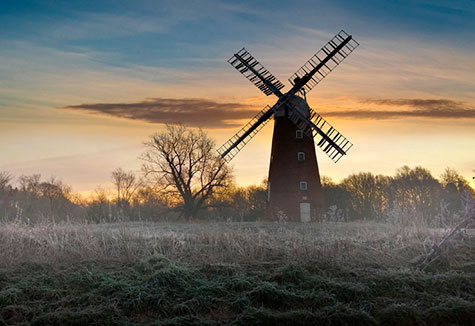 |
2023 |
2023 |
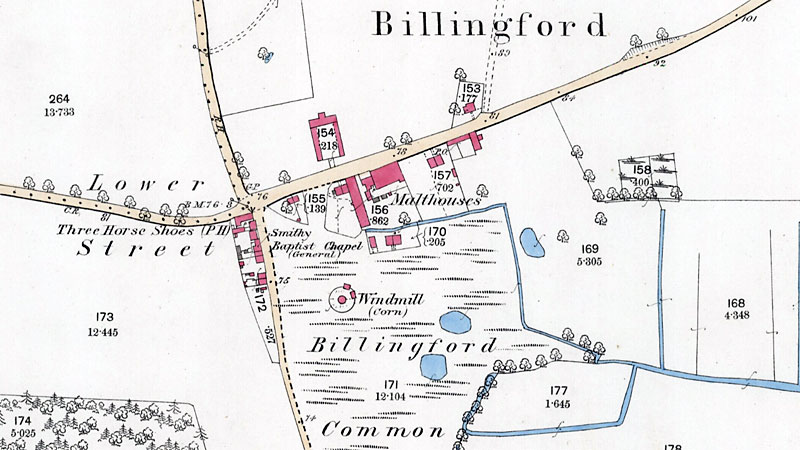 |
O. S. Map 1884 Courtesy of NLS map images |
| 1859-60: Towermill
built by W. Skinner for William Chaplyn of Diss at a cost of £1,300 March 1860: George Goddard, miller (tenant)
White's 1864: George Goddard, corn miller
|
If you have any memories, anecdotes or photos please let us know and we may be able to use them to update the site. By all means telephone 07836 675369 or
|
| Nat Grid Ref TM 16707857 |
Copyright © Jonathan Neville 2004 |